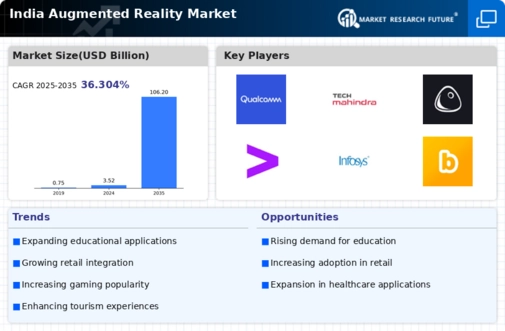Integration of AR in E-commerce
The integration of augmented reality in e-commerce platforms is transforming the shopping experience for consumers in India. Retailers are leveraging AR to provide virtual try-ons and interactive product displays, enhancing customer engagement. This trend is particularly evident in the fashion and furniture sectors, where AR applications allow customers to visualize products in their own environments. As a result, the augmented reality market is witnessing a significant uptick, with estimates suggesting that AR-enhanced e-commerce could account for over 20% of online sales by 2026. This integration not only improves customer satisfaction but also drives sales, making it a key driver for the augmented reality market.
Government Initiatives and Support
The Indian government is actively promoting the adoption of augmented reality technologies through various initiatives and policies. Programs aimed at fostering innovation in technology sectors are likely to provide a conducive environment for the augmented reality market. For example, the Digital India initiative encourages the use of advanced technologies, including AR, in various sectors such as education and healthcare. This governmental support is expected to stimulate growth, with projections indicating that the augmented reality market could see a compound annual growth rate (CAGR) of over 25% in the coming years. Such initiatives are crucial for establishing a robust AR ecosystem in India.
Increased Investment in AR Startups
Investment in augmented reality startups in India is on the rise, reflecting a growing confidence in the potential of the augmented reality market. Venture capitalists and angel investors are increasingly funding innovative AR solutions, particularly in sectors like retail and education. Reports suggest that funding for AR startups has increased by approximately 40% in the last year, indicating a strong belief in the market's future. This influx of capital is likely to accelerate the development of new AR applications and technologies, further driving the growth of the augmented reality market in India.
Rising Demand for Immersive Experiences
Consumer preferences in India are shifting towards immersive experiences, which is significantly impacting the augmented reality market. Industries such as entertainment, gaming, and tourism are increasingly adopting AR to create engaging content. For instance, AR applications in gaming have seen a growth rate of around 30% annually, reflecting a strong consumer interest. This demand for immersive experiences is prompting businesses to explore AR solutions to enhance customer engagement and satisfaction. As a result, the augmented reality market is poised for expansion, with companies investing in innovative AR applications to meet this growing consumer expectation.
Technological Advancements in AR Devices
The augmented reality market in India is experiencing a surge due to rapid technological advancements in AR devices. Innovations in hardware, such as lightweight headsets and mobile AR applications, are enhancing user experiences. The integration of AR with artificial intelligence and machine learning is also driving this growth. As of 2025, the market for AR devices is projected to reach approximately $5 billion, indicating a robust demand. This technological evolution is not only making AR more accessible but also more appealing to various sectors, including education and retail. Consequently, The augmented reality market is expected to attract more investments from startups and established companies..
























Leave a Comment